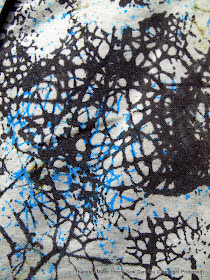Thanks so much for your support of my dress called "Harvey". Because of your votes, I won round one of the Fabric Mart Challenge! The second challenge is to take a basic t-shirt dress pattern and transform it into a
transitional piece for fall. We are encouraged to hack the pattern to change it in some way. Here is my entry and you can vote for it on the Fabric Mart page here.
In Pearland, Texas, Fall arrives around
Thanksgiving and is pretty much indistinguishable from Winter. The weather
requires long sleeves, light jackets and long pants or skirts. With the
high Summer temperatures, buildings are cooled to shivers requiring
transitional dress on a daily basis to account for the shift. I usually have a
hoodie, or kimono in my car to throw on for a trip to a store or movie.
I made a maxi length duster to serve as a topper to jazz up everyday jeans and a t-shirt. I found a wonderful Vlisco African Wax with a bold floral motif.
It looks great coming
And going
and everything in between.
To add to the transitional
element, I made it fully reversible with the other side in a luscious black linen.
When worn on the black side, the cuffs and lapels can be turned to show the contrast print.
The wax side has side seam pockets. What's the point of sewing if you can't put pockets in everything?
the black side has crescent-shaped pockets positioned on the outside.
For this challenge, I hacked the pattern we were given. My pattern stash is large so I rarely pattern hack. I will generally explain what I did here:
This pattern has very little ease and is designed for knits. To modify it for the
duster, I looked at the finished garment measurements that coordinated with the
amount of ease I wanted.
If I was making the dress,I would have chosen the size 12/14. For this conversion from dress to duster, I went with the
size 20 and graded out the hips and increase the length to a maxi length. I did
the same for the sleeves and graded them down to get to my appropriate size. I omitted
the front fold and cut it open. I used a retro pattern that had a similar width
and length as my guide for increasing this pattern.
To make this duster reversible, I constructed
both sides individually leaving an opening in the sleeve of one for
turning to the right side.
With right sides together, I stitched completely around the edges joining the linen fabric to the wax print fabric before turning it right side out. To finish the edges of the sleeves, pull them out as high as the armpit keeping them free of twists. Make sure the duster is right side out (ask me how I know!), then pull the sleeves out through the opening. Match up the seams then fold each sleeve end back to reveal the right sides. With raw edges even, pin in place and stitch the sleeve ends together.
After turning the sleeves inside I hand-stitched the opening closed.
I really enjoyed playing with the placement of the flower motifs on this duster. I print matched the front and centered a flower on each arm.
Come on Fall! I am ready for you!
Happy Sewing,
Bianca





























